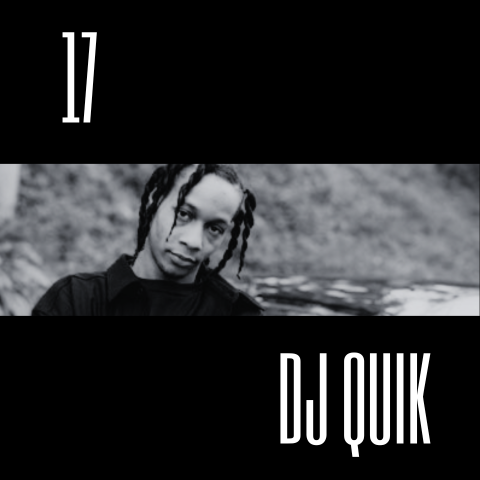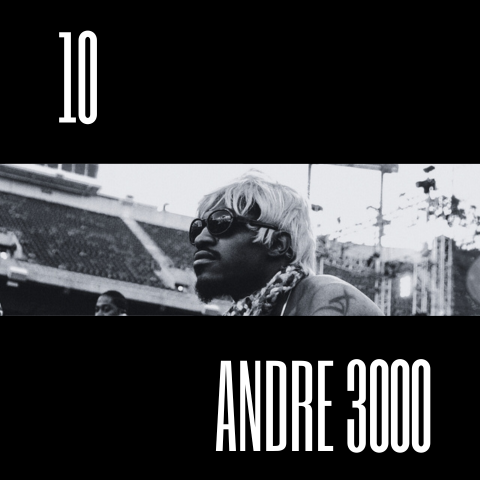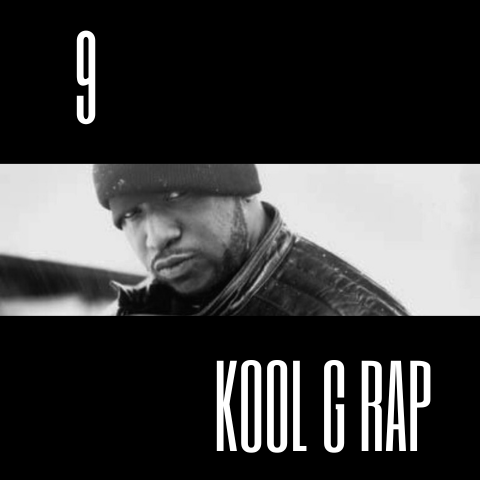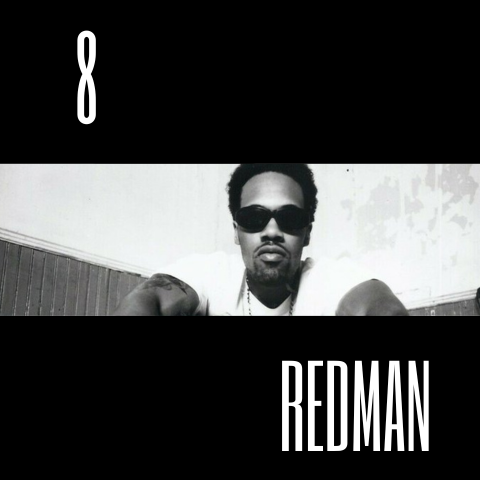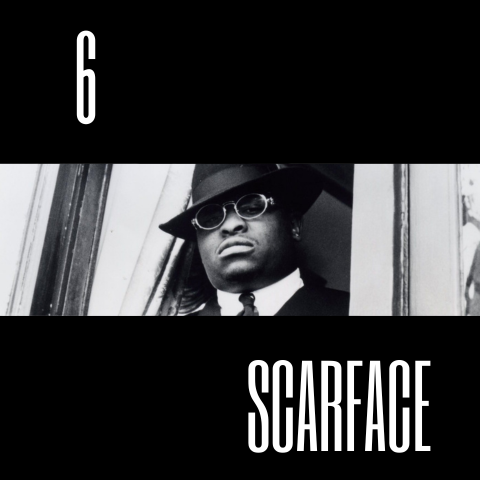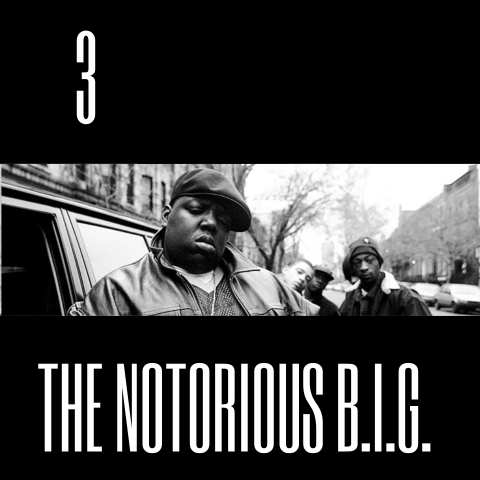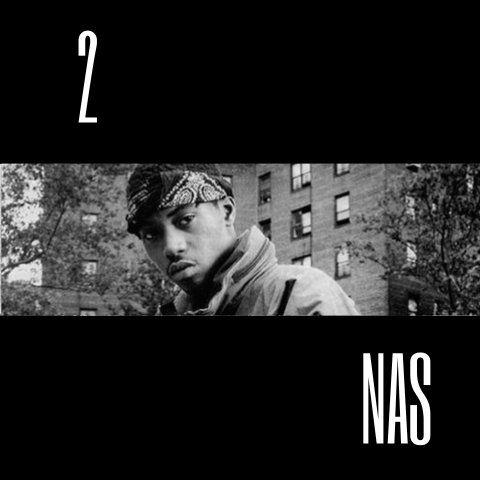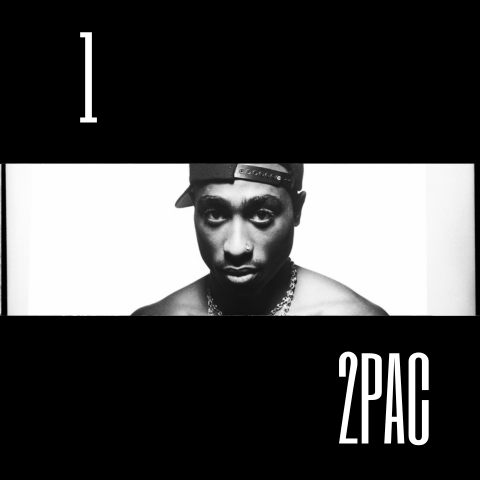The Top 20 Greatest Rappers Of The 1990s
The 1990s, a time where you had to call your friends from your landline, wait for your favourite song to play on the radio and patiently wait for the internet to connect through a noisy dial-up modem. This decade is often considered the greatest, largely because it struck the right balance between analog and digital, marked the beginning of new political and social progress, and saw economic prosperity towards the end. However, one factor that significantly influences the 1990s being crowned by many as the greatest decade is the explosion of pop culture. People who lived through different decades might argue that their era was better for various social, political, or economic reasons. Yet, when it comes to pop culture, those who don't represent the ‘90s will have a hard time competing with those who do. The reason is simple: the 1990s was a golden era for music, film, and television.
Specifically for hip-hop, the 1990s is regarded by most as the genre's golden age. The years 1992 to 1996 are arguably the best four years hip-hop has ever seen, and the decade as a whole introduced a plethora of artists and albums that redefined the genre and elevated the standard of the music to a whole new level. While much of the 1980s saw hip-hop evolve from a subculture in New York City to the beginning of a global phenomenon, the 1990s expanded upon this growth exponentially. Many of hip-hop’s naysayers during the genre’s infancy, who thought it was a fad that would quickly die out, were thankfully proven wrong by the genre's success both commercially and creatively during the 1990s.
Though the East Coast—specifically New York City—is the birthplace and mecca of hip-hop, the ‘90s saw various other cities making their mark on the hip-hop map. The West Coast had an incredible decade, competing strongly with the East Coast for the spotlight, thanks to artists like 2Pac, Snoop Dogg, Ice Cube, and others. The decade also witnessed the rise of Southern hip-hop and its respective cities. Geto Boys members and Houston legends Scarface, Willie D, and Bushwick Bill helped pioneer Southern hip-hop. Though they debuted in the 1980s, their 1991 album We Can’t Be Stopped gained more national attention than their previous projects, largely due to the classic single "Mind Playing Tricks On Me." In Atlanta, Georgia, two rappers named Andre 3000 and Big Boi formed OutKast, bringing attention to their home city, which would dominate the following two decades and be at the forefront of hip-hop. Similarly, in the Midwest, artists like Common, Bone Thugs-N-Harmony, and even Eminem, towards the end of the decade, did the same for their respective Midwestern cities. However, this doesn't mean that the East Coast wasn’t producing its fair share of talent; the ‘90s saw the emergence of icons like Nas, Wu-Tang Clan, Biggie, and many more.
Though this introduction was lengthy, it serves a purpose for what follows next. If the 1990s is the greatest decade in hip-hop, who was the greatest rapper during this greatest decade? The paragraph above suggests that there are many to choose from, and it only mentions a small crop of great artists. Today, find out who ARDYReviews believes is the greatest rapper of the 1990s. To develop this ranking and determine the placement of the rappers who made it onto the final list, a specific criteria was established, consisting of three factors: the quality of the artist’s discography, the impact and influence they had within the genre, and lastly, their skill level. To clarify, the criteria focus solely on the artist’s contributions within the 1990s, meaning anything they may have done in previous or future decades was not considered. Only their discography in the ‘90s, their influence and impact within the ‘90s, and even their skillset within the ‘90s were considered. An artist could have fallen off in the 2000s, but as long as they were heavily active and did well in the 1990s, they had a strong chance of making this list. With all that being said, let’s finally get into the list and start at number 20.
While the Geto Boys were helping to put Houston and the entire South on the hip-hop map, a duo not too far from them in Port Arthur, Texas, was following right behind, also helping to generate respect for the South. That duo would be known as UGK, comprised of the late great rapper-producer Pimp C and the talented MC, Bun B. One of the most revered and respected hip-hop acts to ever emerge from the South, UGK released three studio albums that would leave a lasting impact. Their 1992 debut, Too Hard To Swallow, introduced the group with multiple classic singles, including "Something Good," "Pocket Full of Stones," and "Use Me Up." Their follow-up album, Super Tight, showcased further growth in both members of the duo and added another beloved single to their arsenal, "Front, Back & Side to Side."
The duo's third studio album brought them more success and attention than their previous two efforts. Released in 1996, Ridin' Dirty is widely regarded as UGK’s greatest album and one of the best to ever come out of the South. Despite not having a lead single or a music video, Ridin' Dirty achieved greater commercial success than Too Hard to Swallow and Super Tight. From both a production and lyrical standpoint, the album felt more focused and creative. Bun B, in particular, showcased significant growth, delivering many standout moments, with none more incredible than his verse on the album's third track, "Murder." On this song, Bun B delivers his most memorable performance with aggressive, rapid-fire delivery, vivid imagery, and intricate rhyme schemes.
With Pimp C’s charismatic personality and Bun B’s more laid-back demeanour, it may explain as to why Bun B occasionally doesn’t receive the same level of credit as his friend and UGK partner. However, from a rapping perspective, Bun B was always leagues ahead of Pimp C. While Pimp C shone through his production and charisma, Bun B consistently stood out for his lyrical abilities. Though Bun B’s first solo album, Trill, wouldn’t be released until 2005, his work as a UGK member throughout the 1990s established him as a highly respected rapper and one of the best of the decade, even if it took some time for people to fully acknowledge that.
The first of three Wu-Tang Clan members to make it onto this list (sorry for the spoiler), Brooklyn native GZA, also known as The Genius, initially started as a solo artist before joining the nine-man group. After signing with Cold Chillin’ Records, a label known for releasing some of the most respected hip-hop albums of the 1980s, GZA released his debut album, Words From The Genius, in 1991. However, the label failed to promote the album effectively, leading to GZA’s frustration. He eventually asked to leave the label and joined the Wu-Tang Clan, a group formed by his cousin, RZA. When the group’s debut album, Enter The Wu-Tang (36 Chambers), was released, it made a huge impact, and GZA quickly became one of the standout members of the Clan.
While RZA’s production was known for its hard-hitting beats and members like Ghostface Killah and Ol’ Dirty Bastard (ODB) were recognized for their aggressive rap styles, GZA distinguished himself with his calm delivery. His intricate rhymes, filled with references to science, philosophy, and street narratives, established him as one of the top MCs within the group. After the success of the group’s debut album, attention shifted to the creation of solo albums for different Clan members. Method Man, ODB, and Raekwon were the first three to release their solo projects, all of which achieved critical and commercial success. GZA was the fourth member to release a solo project—Liquid Swords, released in November 1995, finally gave GZA the success that had eluded him with his first album.
Compared to Method Man’s Tical or Raekwon’s Only Built 4 Cuban Linx…, GZA’s sophomore album was incredibly experimental and abstract in both its production by RZA and its lyricism and themes by GZA. Liquid Swords is widely regarded as one of the best hip-hop albums of the 1990s, and its quality has led many to argue that it is the best Wu-Tang Clan solo album. During Wu-Tang’s peak run from 1993 to 1997, GZA’s abilities and artistry were otherworldly. As one of the most intellectual rappers, GZA not only set himself apart from his group but also from the hip-hop world as a whole.
Known for his politically charged lyrics, militant stance, and unapologetic commentary on social issues, Paris is often overlooked for his musical talent. He debuted in 1990 with The Devil Made Me Do It, quickly gaining notoriety for his uncompromising views and setting the tone for the type of artist he would become. Paris’ debut album is direct and unapologetic, with themes and lyrics that pull no punches. The lead single, also titled "The Devil Made Me Do It," was banned by MTV, reflecting the pushback Paris faced early in his career.
However, this didn’t deter Paris. In fact, he became even more controversial with his second album, Sleeping With the Enemy. This album featured Paris’ most controversial track to date, "Bush Killa," a fictional narrative about assassinating then-President George H.W. Bush. The album faced significant backlash even before its release. Tommy Boy Records, Paris’ label at the time, refused to release it due to concerns about its content, particularly the track "Bush Killa." As a result, Paris was dropped by the label and chose to release the album independently.
Operating outside the mainstream for the remainder of the 1990s and beyond, and not receiving promotion for his first two albums, this contributed to his lack of recognition compared to other artists. Some may view his unwavering stance as a hindrance that limited his commercial success, but coming from the San Francisco Bay Area made Paris the first socially conscious rapper to emerge from the region. His powerful words and commentary earned him the title of "The Black Panther of Hip-Hop."
By the early 1990s, Dr. Dre and Death Row Records had shifted the spotlight from the East Coast to the West Coast, with G-Funk becoming a highly successful sub-genre. Albums like The Chronic and Doggystyle sold millions of copies, but Dr. Dre and Snoop Dogg weren’t the only ones making groundbreaking music for the West Coast. DJ Quik was another pivotal figure. Born and raised in Compton, Quik became a notable addition to the list of great hip-hop artists from the city with the release of his debut album, Quik Is the Name, in 1991. Incorporating a sample-heavy G-Funk sound, Quik’s debut came a year before The Chronic.
Throughout the 1990s, DJ Quik had an impressive run, releasing a string of great albums, with standouts including his debut, 1995’s Safe + Sound, and 1998’s Rhythm-al-ism. Not only was Quik performing on his albums, but he was also responsible for producing his own music, making him arguably the best rapper-producer of the 1990s. His ability to blend smooth, funk-inspired production with sharp, witty lyricism established Quik as one of the most pivotal and innovative figures on the West Coast.
While the success of Death Row Records was crucial for the West Coast, it sometimes overshadowed other pioneers and significant figures who deserve recognition. This includes artists like Compton’s Most Wanted, Warren G, Above The Law, and DJ Quik. Although Quik achieved commercial success, with all his albums in the '90s going either Gold or Platinum, he didn’t reach the same level of mainstream dominance as 2Pac, Snoop Dogg, or even Ice Cube. This might be why he hasn't received as much credit outside of the West Coast. However, to true music fans, Quik is recognized as a quintessential figure for the West and simply a fantastic artist.
The second Wu-Tang Clan member to make this list, Method Man, was clearly the star within the nine-man group. On the Clan’s classic debut album, Enter the Wu-Tang (36 Chambers), he was the only member to have a solo track, aptly titled "Method Man." This highlights RZA’s foresight in recognizing that Method Man would be the breakout star after the debut. Meth distinguished himself with his charisma, distinctive raspy voice, and the success of his solo track and debut album, Tical. He quickly became the first crossover star within the group.
Method Man’s star power continued to rise with each milestone in his 1990s career. Not only was he given a solo spot on the group’s debut, but he was also the first member to release a solo project. Wu-Tang Clan’s legendary run of solo albums between the first and second Wu-Tang albums was set in motion by the success of Tical. Beyond his involvement with the Wu, Meth also formed a beloved partnership with Redman. Although not as iconic as the Wu-Tang Clan, the duo of Method Man and Redman was incredibly successful, and their chemistry was even more dynamic than what Meth shared with any individual Wu-Tang member. Their first album together, Blackout!, was well received, and the pair became popular not only within hip-hop but also in pop culture.
With his success in the Wu-Tang Clan, his solo career, and his collaboration with Redman, Meth became one of the biggest hip-hop stars of the 1990s. His ability to transition smoothly between solo and group projects speaks to his immense talent. As Wu-Tang Clan crossed over into mainstream success, Method Man played a pivotal role in making that happen. His star power, combined with hit singles like "Bring the Pain," "You’re All I Need" featuring Mary J. Blige, and "Da Rockwilder" with Redman, solidified him as one of the most beloved rappers of the decade.
Kool Keith, known for his multiple alter egos, developed a cult-like following in the 1990s with his abstract sound and unconventional personas. He first established himself as one of the five members of the Bronx-based group Ultramagnetic MCs during the late 1980s and early 1990s. After the release of two albums in 1992 and 1993, the group wouldn’t release a project that lived up to the same level as their debut, Critical Beatdown, which was released in 1988. Following the group's third album, Funk Your Head Up, Keith, who was one of the group’s standout members, shifted his focus to a solo career after the group disbanded. This transition allowed Kool Keith to explore his creative aspirations without the constraints of working within a group.
Keith’s first solo album, Dr. Octagonecologyst, released under his Dr. Octagon alter ego, became a significant hit in the underground hip-hop scene. Produced almost entirely by Dan the Automator, the album blended sounds from various genres and sub-genres, such as horrorcore, trip-hop, and electronic music. While other alternative hip-hop records emerged around the same time, Dr. Octagonecologyst stood out due to its unique production, concept, and lyricism. Towards the end of the 1990s, Keith continued to release innovative and well-received albums, particularly First Come, First Served and Black Elvis/Lost in Space—both released in the same year—which introduced more alter egos, Dr. Dooom and Black Elvis.
Although Kool Keith never achieved massive commercial success, he became a legend in the underground hip-hop scene. As the late 1990s saw a growing divide between commercial and underground hip-hop, Keith was recognized as one of the best rappers within the underground scene. Alongside acts like MF DOOM, Company Flow, Talib Kweli, and Mos Def, who were also releasing some of the finest underground albums during this period, Kool Keith held his own. His journey from being a group member with Ultramagnetic MCs at the end of the 1980s, to one of the most unique solo rappers by the end of the 1990s, showcases his incredible talent, creativity, and longevity within those ten years.
The highest-ranked Wu-Tang Clan member on this list, Ghostface Killah is arguably the greatest of all nine members. Compared to GZA and Method Man, who were featured earlier, Ghostface earns his higher placement due to his involvement in more iconic tracks and albums throughout the 1990s. On Enter the Wu-Tang (36 Chambers), Ghostface appears on more tracks than GZA and delivers more standout verses than Method Man. His verses on "Bring Da Ruckus" and "Tearz" are the best on each song. While the chemistry between Method Man and Redman was strong, it doesn't quite reach the level of the partnership between Ghostface and Raekwon. Their collaboration on "Can It Be All So Simple" is one of the best tracks on 36 Chambers. Additionally, Ghostface's heavy presence on Raekwon’s classic debut album, Only Built 4 Cuban Linx..., which is widely regarded as the best solo Wu-Tang album, solidifies his higher placement on this list.
Unlike GZA and Method Man, Ghostface released only one solo album during the 1990s, but his debut, Ironman, is an exceptional project. The album features some of Ghostface’s best tracks, including "Assassination Day," "Daytona 500," and "All That I Got Is You." Alongside Only Built 4 Cuban Linx... and Liquid Swords, Ironman ranks among the top three solo Wu-Tang albums of the ‘90s. As mentioned, Ghostface's heavy involvement in Raekwon’s 1995 debut album was crucial; without him, one could argue that Only Built 4 Cuban Linx... wouldn't have achieved its legendary status. Much like how The Chronic is as much Snoop Dogg’s album as it is Dr. Dre’s, Only Built 4 Cuban Linx... is as much Ghostface’s album as it is Raekwon’s.
Ghostface Killah brought a mix of raw street imagery, intricate slang, and a deeply personal, almost confessional approach to his lyrics. He excelled on various types of tracks, whether it was the aggressive, hard-hitting Wu-Tang anthems like "Bring Da Ruckus" and "Protect Ya Neck," the laid-back, Soul-inspired "Camay," or the somber, introspective "All That I Got Is You" featuring Mary J. Blige. His work during the ‘90s would set the tone for the rest of his solo career, as he would continue to produce more great work beyond the decade.
One half of the Atlanta hip-hop duo OutKast—arguably viewed as the greatest duo in hip-hop history by fans and critics alike—Big Boi opted for a more streetwise approach to his lyrics in comparison to André 3000’s abstract style. Debuting in 1994, the duo helped put Atlanta on the hip-hop map and had an amazing creative run between 1994 and 1998. While many artists within the genre have had great three-album runs, few can compare to OutKast's. Southernplayalisticadillacmuzik, ATLiens, and Aquemini are not only Southern hip-hop classics but hip-hop classics as a whole.
Both Andre and Big Boi are incredible MCs, Big Boi in particular was more grounded and pragmatic with his lyricism. With each album the duo pushed themselves to new creative heights and each of those three albums were different from each other. Big Boi grew as a rapper with each release, from witty streetwise wordplay on the duo’s debut, he became more introspective on ATLiens and Aquemini. The duo provided multiple classic songs throughout the decade. Their debut single, “Player’s Ball”, is one of the most important songs to ever come out of the South. Their second and third albums consisted of multiple Hip-Hop hits, from the likes of “Elevators (Me & You)”, “ATLiens” and “Rosa Parks”. Whilst, “Da Art Of Story Tellin Pt.1” is one of the greatest Hip-Hop storytelling tracks of all time.
Though Big Boi didn’t release a solo debut album until 2010’s Sir Lucious Left Foot: The Son of Chico Dusty, he played a pivotal role in crafting three classic albums. Being one half of OutKast, and knowing the impact they had and how important they are to Hip-Hop—specifically Southern Hip-Hop—cements Big Boi's place in the ranks. As dominant as the South has been since the 2000s, that dominance might never have happened if OutKast hadn’t emerged. During the 1990s, the South was fighting for both relevancy and respect at a time when the focus was heavily on the West and East Coasts. Big Boi and André 3000 were instrumental in starting the journey that led to the South gaining that respect and for the city of Atlanta becoming the forefront of Hip-Hop.
Releasing his debut album Reasonable Doubt in 1996, with only a few featured appearances and one released single prior to it, some might think that Jay-Z didn’t have enough output to be placed at number twelve on this list. However, the Brooklyn native released three more albums before the end of the decade. Four albums in four years prove that Jay-Z has the quantity to feature on this list, but also he has the quality. His debut album, Reasonable Doubt, is a classic debut however upon its release it was a quiet hit with critics and fans that knew about it. Though releasing twelve more albums after his debut, Jay-Z’s first album contains some of his best work, with classics such as “Can I Live”, “D’Evils” and “Dead Presidents II”.
Reasonable Doubt is often cited for its quality within Jay-Z’s catalog in the 1990s, while his third album, Vol. 2… Hard Knock Life, is known for its massive commercial success. Jay-Z’s debut isn’t his only standout album from the '90s—Vol. 2 is not just the album that catapulted him into the mainstream but is also another great project. His sophomore album, In My Lifetime, Vol. 1, is widely regarded as a disappointment, even by Jay himself. In retrospect, it may not reach the level of the other albums mentioned, but it is still a solid project overall. His final album of the decade, 1999’s Vol. 3... Life and Times of S. Carter, is weaker than his previous three albums, though it is by no means a bad record. Between 1996 and 1999, Jay-Z released four good projects back to back, and it wouldn’t be until 2002’s The Blueprint 2 that he would deliver a weak effort.
From a rapping standpoint, Jay-Z started the decade with a fast-paced, complex flow but gradually evolved, slowing down his delivery while consistently showcasing great lyricism and wordplay. His impact and influence would become more prominent after the '90s, but it began in this decade as he became one of the earliest examples of a hip-hop mogul. Starting fully independent with his record label, Roc-A-Fella, which he co-founded with Kareem “Biggs” Burke and Dame Dash, the label eventually became part of the Def Jam Records family. With the commercial success of his second and third albums, Jay-Z was part of Def Jam’s second legendary run, alongside DMX, Foxy Brown, Method Man, and Redman, following the label’s first major run in the 1980s.
Perhaps given more credit for his production work, Q-Tip should not be slept on as a rapper. An integral member of one of the greatest Hip-Hop groups of all time, Q-Tip’s contribution rapping wise should be given the same amount of merit as his producing for the group. Q-Tip and Phife Dawg both provided vocal contributions to the group, however on Tribe’s first classic album, People’s Instinctive Travels and the Paths Of Rhythm, Phife wasn’t as present in comparison to the albums that followed. Q-Tip took the reigns of rapping on the majority of the group’s debut, and this consisted of their first breakout hits such as “Can I Kick It”, “I Left My Wallet In El Segundo” and “Bonita Applebum”. Q-Tip’s performances on the latter albums were also great from “Check the Rhyme” on The Low End Theory to “Midnight” on Midnight Marauders.
Q-Tip’s role in the group’s success cannot be overstated. A Tribe Called Quest had an incredible run in the early 1990s, delivering one of the greatest three-album runs in hip-hop history. While many critics and fans consider their sophomore effort, The Low End Theory, to be the group’s magnum opus, their debut and Midnight Marauders are equally celebrated as some of the best hip-hop albums of the decade. Q-Tip’s jazz-inspired production, paired with his charismatic and smooth delivery, helped define the group’s sound and legacy. His influence resonates deeply within the genre, with artists like André 3000, Pharrell Williams, and Kanye West frequently citing Q-Tip and A Tribe Called Quest as major inspirations. The group’s ability to balance socially conscious lyrics with mainstream-friendly songs solidified their place as trailblazers in hip-hop.
While the end of the decade didn’t maintain the same level of excellence, with Tribe’s 1998 album The Love Movement and Q-Tip’s first solo effort Amplified receiving mixed reviews, there were still notable highlights. Tracks like “Find My Way” from The Love Movement and “Vivrant Thing” from Amplified showcased moments of brilliance. Despite a slight dip in critical acclaim toward the end of the ‘90s, Q-Tip’s work during the group’s peak years—particularly between 1990 and 1993—was so impactful that it far outweighs the less celebrated moments that followed.
The more abstract and unconventional member of OutKast, André 3000 broke barriers and paved the way for countless rappers who followed in his footsteps. His eclectic style and artistic evolution—from the duo’s debut album, Southernplayalisticadillacmuzik—can be seen and heard in artists like Kendrick Lamar, Denzel Curry, and JID. As previously mentioned in regard to Big Boi, OutKast is widely regarded as the greatest duo in hip-hop history by fans and critics alike. Beyond that, the group helped put Atlanta on the hip-hop map and achieved an incredible run of classic albums between 1994 and 1998. Few rappers have demonstrated the kind of stylistic evolution and growth that André did between the duo’s debut and their sophomore album, ATLiens. During this period, André transitioned from wearing Atlanta Braves hats and baggy clothing to donning turbans and embracing a more experimental, avant-garde sense of style.
While Big Boi is a phenomenal rapper in his own right, as evidenced by his placement on this list. As mentioned, Big Boi would grow lyrically from an album to album, however Andre would do the same on a bigger scale. Both members showcased incredible lyricism on their debut, making it hard to determine who was stronger. However, by ATLiens and Aquemini, André’s artistry began to stand out more clearly. He stole the spotlight on tracks like “Two Dope Boyz (In a Cadillac)” and “Da Art of Storytellin’ Pt. 1.” His individual impact extended beyond his rapping, encompassing his bold artistic evolution, his unique delivery, and his unforgettable statement at the 1995 Source Awards: “The South got something to say,” made during OutKast’s acceptance speech after being booed by the crowd.
To this day, fans from multiple generations continue to plead for André’s first solo rap album—a project that has yet to materialize and, most likely, never will. This enduring demand speaks volumes about how beloved André 3000 is within the hip-hop community, much of which stems from his groundbreaking work during the 1990s. Universally regarded as the greatest Southern rapper of all time, it’s a title he rightfully earned. He not only helped the South gain the respect it deserved during an era of East and West Coast dominance but also played a pivotal role in positioning the region—specifically Atlanta—as the forefront of hip-hop.
A highly influential rapper in the 1990s—though often not given full credit, largely due to a lack of mainstream commercial success—Kool G Rap laid the blueprint for the Mafioso sub-genre of hip-hop that became popular in the late ’90s. The Notorious B.I.G., Jay-Z, Nas, and Raekwon all released some of the most highly respected hip-hop albums of that era, and each of them reflected Kool G Rap’s influence. The Queens native began his career in the late 1980s alongside DJ Polo, releasing Road to the Riches (1989), followed by Wanted: Dead or Alive (1990) and Live and Let Die (1992). All three projects are now regarded as classic East Coast albums.
The ’90s also marked the beginning of G Rap’s solo career, with the release of his debut album, 4,5,6 (1995), and his sophomore effort, Roots of Evil (1998)—both of which are well received. The former became his most commercially successful album, bolstered by the single “Fast Life” featuring Nas. His collaborations with DJ Polo and his solo projects were filled with vivid storytelling and consistently elite lyricism, detailing crime narratives and the emerging Mafioso rap aesthetic. Standout tracks include “Streets of New York,” “Ill Street Blues,” and “Fast Life,” while his guest appearances on songs such as “Stick to Ya Gunz” with M.O.P. and “The Realest” from Mobb Deep’s Murder Muzik further showcase his great rapping abilities.
Even beyond the 1990s, Kool G Rap’s influence has remained undeniable, with artists from Beanie Sigel to the present-day with the Griselda movement all carry elements of his style. His impact on East Coast Hip-Hop, particularly in shaping the gritty and street-oriented storytelling proves that his legacy is timeless. Though he never achieved the mainstream stardom similar to some of the names mentioned previously, he is still recognised as one of the best rappers in Hip-Hop history.
Having one of the biggest growths as an artist during the 1990s - Redman would go from being Erick Sermon of EPMD’s protege in 1990 to becoming mainstream star by 1999 with his partnernship with Method Man. He made his debut appearance on EPMD’s third album, Business As Usual, on the track “Hardcore” and soon became part of the Hit Squad collective, which was mentored by EPMD and included the likes of Das EFX. After the Hit Squad disbanded, Redman became a member of Def Squad, alongside Erick Sermon, Keith Murray, Jamal, and Hurricane G. By 1992, Redman released his classic debut album, Whut? Thee Album, which featured some of his best work, including tracks like “How to Roll a Blunt,” “Time 4 Sum Aksion,” and “Tonight’s da Night.”
He developed a strong rapper-producer partnership with Erick Sermon, who played a key role in shaping the sound of Redman’s early albums. His second and third albums, Dare Iz a Darkside (1994) and Muddy Waters (1996), are also regarded as classics, with the latter often considered his best work. This gave Redman an impressive three-album run, solidifying his reputation as one of the most consistent artists of the decade. Towards the end of the ’90s, the New Jersey native achieved greater mainstream success while still delivering high-quality material. His 1998 album, Doc’s da Name 2000, may not receive the same level of appreciation as his first three projects, but it became his most commercially successful solo album to date. Then, just two months before the decade ended, he released Blackout! with Method Man. Both a critical and commercial success, the album spawned the classic single “Da Rockwilder,” which remains one of the most recognizable hip-hop tracks of its era.
Despite never compromising his sound or forcing himself to appeal to mainstream audiences, Redman still managed to cross over—an achievement that many rappers have struggled to accomplish. His music stood out from that of his East Coast contemporaries, as his albums incorporated heavy funk influences, setting him apart from the more traditional boom-bap production dominating the region at the time. A consistently engaging and highly entertaining MC, Redman’s unique blend of humor, wordplay, and raw delivery made him one of the best rappers of the 1990s. His influence can be seen in later artists, particularly Eminem, who has frequently cited Redman as one of his favorite rappers and a major inspiration.
Already making a name for himself in the previous decade as a member of N.W.A., Ice Cube left the group after the success of their debut album, Straight Outta Compton, due to contract disputes and financial disagreements. Embarking on a solo career, Cube teamed up with Public Enemy's production team, The Bomb Squad, to create his debut album, AmeriKKKa's Most Wanted, which was released in 1990. Many thought he was making a mistake by leaving N.W.A., but Cube quickly proved doubters wrong, achieving both critical and commercial success with his debut. The album remains one of the greatest hip-hop debuts of all time and marked the beginning of Cube’s legendary three-album run.
Prior to his second album he would release the EP Kill At Will which has always been a fan favourite, and in 1991 Death Certificate was released. Similar, to his first album Cube is aggressive in his delivery of race and social commentary. If AmeriKKKa's Most Wanted is one of the best debuts then Death Certificate is one of the greatest sophomore albums of all time. With it also including one of the greatest diss tracks of all time, that being “No Vaseline”, which was aimed at his former group N.W.A. Cube continued his dominance in 1993 with The Predator, which featured his biggest hit single, “It Was a Good Day.” Alongside its classic lead single, the album was another critically and commercially successful project, further solidifying Cube’s status as one of the most important voices in hip-hop.
The second half of the decade was more mixed for Cube. He joined forces with fellow West Coast rappers Mack 10 and WC to form Westside Connection, releasing a solid album, Bow Down, which was well received. However, his 1998 solo release, War & Peace Vol. 1 (The War Disc), didn’t meet the same standard as his previous solo efforts. Despite this, that slight misstep was only a minor blemish on what was an incredible decade for Cube. His early ’90s run—including AmeriKKKa’s Most Wanted, Kill at Will, Death Certificate, and The Predator—was more than enough to solidify his place as one of the greatest rappers of the era.
Houston’s very own Scarface had an incredible run during the 1990s, excelling both as a solo artist and as a member of the legendary Southern trio, the Geto Boys, alongside Bushwick Bill and Willie D. Throughout most of the decade, Scarface alternated between releasing strong projects as solo artist and with his group. In 1991, he played a key role in two major releases: his debut solo album, Mr. Scarface Is Back, and the Geto Boys' We Can’t Be Stopped. The latter became the group’s most celebrated album, featuring the iconic single “Mind Playing Tricks on Me”—widely regarded as one of the greatest and most important records in Southern hip-hop history.
Three years later, Scarface delivered another landmark track for the South. 1994’s “I Seen a Man Die” is easily Scarface’s best solo track. Much like “Mind Playing Tricks on Me,” the track explores the harsh realities of crime and death with chilling storytelling. The single itself would be a part of Scarface’s classic third album The Diary. By far his greatest album within his respected discography, the album would also include more of his best work, such as “No Tears” and “G’s”. Other notable projects from Scarface’s catalogue during the ‘90s, include the Geto Boy’s self-entitled album released in 1990, and Scarface’s The Untouchable, which featured the powerful 2Pac-assisted hit “Smile.”
Renowned for his impeccable storytelling, Scarface is not only one of the greatest Southern rappers of all time but one of the greatest rappers, period. His work with the Geto Boys and his solo material helped give the South its first taste of credibility during an era dominated by the East and West Coasts. His influence proved that the South had just as much lyrical depth and artistic talent as any other region, paving the way for the rise of Southern hip-hop’s dominance in the 2000s and beyond.
Guru’s placement and legacy in Hip-Hop is an interesting case. Devout hip-hop fans recognise his greatness, yet his name is often overlooked or placed below other rappers in broader discussions. His discography in the ’90s is nearly flawless, and if someone were to argue that it was the best of any rapper from that era, it would be difficult to refute. Releasing two solo albums and four projects as one half of Gang Starr alongside legendary producer DJ Premier, Guru’s body of work in the ’90s can stand against anyone’s. Throughout this list, various artists have been praised for their three-album runs, but Guru stands alone with Premier, achieving an unmatched four-album streak that lasted the entire decade.
Gang Starr released four classic albums during this period: Step in the Arena (1991), Daily Operation (1992), Hard to Earn (1994), and Moment of Truth (1998). Each project is beloved in hip-hop, featuring multiple standout tracks such as “Just to Get a Rep,” “Ex-Girl to Next Girl,” “Mass Appeal,” and “Work.” In between Gang Starr’s second and third albums, Guru also released his first solo project, Jazzmatazz, Vol. 1 (1993). The album would take the sub-genre of Jazz-rap to a whole new level, instead of production that sampled Jazz music from the past, Guru would incorporate live instrumentation and collaborations with jazz legends like Donald Byrd. He would also release the album’s sequel in 1995, which was also well received by fans.
Throughout the decade, Guru’s music was synonymous with greatness, whether through his solo work or as one half of Gang Starr. Even with the latter he was the only rapper in the duo, he wasn’t sharing the microphone with anyone else. Despite this, he remains underrated in many rankings, often not placed as highly as he deserves - whether on lists of the greatest rappers of the ’90s or of all time. Perhaps it’s because he wasn’t the flashiest or the most commercially driven, but regardless, Guru’s placement on this list is more than justified.
While gangsta rap helped establish the West Coast as a dominant force in hip-hop, capable of competing with the East Coast’s long-standing influence, it also cast a large shadow over rappers who took a different approach to their music. The alternative and underground scene in the West was filled with great artists, but Del the Funky Homosapien was the most influential and celebrated among them. As a key member of the Hieroglyphics crew—alongside Souls of Mischief, Casual, and others—Del only released three solo albums during the 1990s, but his first two, I Wish My Brother George Was Here (1991) and No Need for Alarm (1993), have since become cult underground classics.
Towards the end of the decade, Del released his final solo album of the ’90s, Future Development, in 1997. Though not as highly regarded as his first two projects, the album was still well received by fans. Its release was yet another example of Del’s defiance against the constraints of the music industry, as he put it out independently after Elektra Records shelved it. A year later, in 1998, he contributed to 3rd Eye Vision, the first full-length album from the Hieroglyphics crew. Much like Del’s early work, 3rd Eye Vision grew to be an underground classic, further cementing Hieroglyphics as one of the most respected collectives in hip-hop.
By intentionally steering away from industry trends and mainstream expectations, Del distinguished himself from his West Coast peers through his intricate lyricism, storytelling, and experimental approach. Del embraced creative freedom, which allowed his music to age gracefully and gain a loyal cult following. His contributions in the 1990s not only made him a staple of underground hip-hop, but also paved the way for alternative rap’s continued evolution in the years that followed.
Hip-Hop started in the East Coast and the region dominated the genre from its birth and all the way through to the 1980s. However, by the early 1990s - specifically with the release of Dr. Dre’s The Chronic in 1992 - the West Coast briefly took the spotlight for itself. The East Coast needed something to reinvigorate its scene and compete with the high-quality production that was defining West Coast G-Funk. While artists like Wu-Tang Clan and Nas were leading the East Coast renaissance, it was Brooklyn’s The Notorious B.I.G. (a.k.a. Biggie Smalls) who put a massive stamp on it, and would help put New York City back on the map.
Although Biggie released only two solo albums between 1994 and 1997, his life and career—tragically cut short—left an enormous impact in just a few years. His debut album, Ready to Die, is widely considered one of the greatest hip-hop albums of all time, with some even arguing that it is the greatest. The album created a blueprint that would be imitated for years, seamlessly balancing raw hip-hop album cuts with commercially viable singles that dominated the radio. Ready to Die is stacked with quintessential tracks, from iconic singles like “Juicy” and “Big Poppa” to gritty album cuts such as “Gimme the Loot” and “Unbelievable.”
Biggie’s follow-up, Life After Death, is another defining album of the decade. One of the few rappers to successfully execute a great double album—an incredibly difficult feat—Biggie continued the formula, delivering more timeless hip-hop records, from the likes of “Mo Money Mo Problems”, “Ten Crack Commandments” and “Notorious Thugs”. The album further showcased his ability to craft hit singles while maintaining his signature lyricism and storytelling prowess.
Despite having only a brief career and two solo albums (excluding posthumous releases), Biggie’s legacy and lasting impact are nothing short of remarkable. He is unquestionably an icon of ’90s hip-hop, and had he built a larger catalog within the decade, he would likely be poised for the top spot. His skill set was arguably the best in comparison to others. His skill set was arguably unmatched—he had the voice, flow, lyricism, and storytelling ability to captivate any audience. He could craft infectious singles, deliver both dark and humorous narratives, and steal the show with his intricate wordplay. In just a few years, The Notorious B.I.G. cemented his place as one of the greatest rappers in hip-hop history.
Considered the second coming of Rakim and widely credited with creating the greatest hip-hop album of all time, Illmatic, Nas was the most exciting new artist to emerge in the early ’90s. His talent was first showcased through standout features on Main Source’s “Live at the Barbeque” and MC Serch’s “Back to the Grill.” When Illmatic was released in 1994, it received a coveted five-mic rating from The Source, the most influential hip-hop magazine at the time. Earning five mics was a prestigious and rare achievement, further solidifying the album’s legendary status. Released when Nas was just 21 years old, his lyricism and storytelling were wise beyond his years. Thirty years on it’s heralded in such high regard in not only Hip-Hop, but in music as a whole. It’s up there with the greatest musical creations of all time - right next to Mile Davies’ Kind Of Blue, Marvin Gaye’s What’s Going On and Stevie Wonder’s Songs In the Key Of Life.
The status of Illmatic and the legacy it has developed in three decades since its release, has created a somewhat shadow on Nas’ albums that came after it. He would release another three albums during the ‘90s. It Was Written had the difficult task of following up Nas’ debut, but it is almost just as good. While Illmatic was critically acclaimed, it was not a major commercial success. However, Nas attained mainstream recognition with It Was Written, largely due to the success of “If I Ruled the World (Imagine That),” the hit single featuring Lauryn Hill.
The year 1999 was an interesting one for the Queens MC, as he released two albums within the same calendar year: I Am… and Nastradamus. Originally, Nas had planned to release a double album, but he became one of the first major artists to suffer from internet leaks. As a result, much of the original material was scrapped, and Nas was forced to quickly record new music, leading to two separate albums instead. Both projects were poorly received at the time, though in retrospect, I Am… is a strong album, blending elements of his first two records. Songs like “N.Y. State of Mind Pt. II,” “Undying Love,” and “Nas Is Like” are among his best, while singles such as “Hate Me Now” and “You Won’t See Me Tonight” are enjoyable singles. Admittedly there is no defence for Nastradamus it sounds rushed and unfocused, however sympathy can be given for the situation that Nas was placed in.
Illmatic is both a gift and a curse for Nas. The album’s quality and legacy are so monumental that they stand against entire catalogs of other artists. However, this same legacy created expectations that no project he released could ever fully match. That shadow has followed him beyond the ’90s, often leading to unfair comparisons. Still, when objectively assessing his body of work, Nas has one of the greatest discographies in hip-hop history. While his 1990s output wasn’t flawless, Nastradamus alone isn’t enough to tarnish the brilliance of his first three albums.
Many artists’ legacies take on a life of their own after they pass, and this is especially true for Tupac Shakur. He is held in such high regard that he has become almost a mythical figure, with his life often told as a legendary tale. For years after his passing, conspiracy theories circulated suggesting he was still alive, further cementing his larger-than-life status. Easily one of the most imitated rappers of all time, countless artists have claimed to be the “new 2Pac” or drawn comparisons between themselves and the late icon. However, that only scratches the surface of 2Pac’s immense influence and impact.
Between 1991 and 1996, he released five solo albums and one collaborative project as a member of the group Thug Life. From the beginning of his career, 2Pac stood out with his unapologetic delivery and fearless approach to addressing issues that remain relevant today, such as racism, police brutality, and social inequality. His first two albums - 2Pacalypse Now (1991) and Strictly 4 My N.I.*.*A.Z. (1993) - were strong, socially conscious efforts that showcased his raw talent. However, his best work came with his next three releases. 1995’s Me Against the World is arguably his best album, the project struck a perfect balance between social commentary and more mainstream records, with “Dear Mama” standing as one of the most iconic songs of his career.
In 1996, he released two phenomenal projects within the same year. First came All Eyez on Me, a double-disc album packed with many of his most well-known songs, including “California Love,” “Ambitionz Az a Ridah,” and “2 of Amerikaz Most Wanted.” Tragically passing a few months after the release of the album, he never lived to see the release of The Don Killuminati: The 7 Day Theory, which showcased a darker, more intense version of his artistry under the alias Makaveli.
Nearly three decades after his passing, 2Pac remains one of the most recognisable figures of the 1990s - transcending hip-hop and music to become a cultural icon. A highly polarising figure, his intellectual and creative genius was sometimes overshadowed by his involvement in the East Coast vs West Coast feud and his adoption of a more aggressive gangsta rap image. Yet, beneath the controversy, 2Pac was an artist, a visionary, and a revolutionary figure whose influence is obvious to this day.





